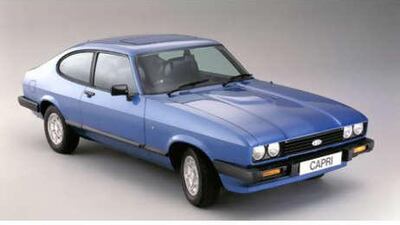Back in the golden days of American car manufacturing in the 1960s, the Ford Motor Company could do little wrong. It developed good, bad, sometimes indifferent motor cars and domestic consumers dutifully bought them by the bucket load. These were simpler times, when talk of possible bailouts, bankruptcy or even an impending Japanese manufacturing invasion would have been written off as the ramblings of a mad man.
Take the Ford Mustang. The original sports car for the common man was developed by Ford as a nice little sideline that might turn over around 100,000 units a year. Instead, only days after its launch, herds of customers headed for their local dealers to place an order for this blue-collar wonder. Within 18 months of its April 1964 release, sales of the Mustang hit a magical seven figures. Across the Atlantic, Ford Europe eyed the Mustang's popularity with some envy and began development work on their own pony car in 1966. In deference to the car's American inspiration, the project was initially named Colt, although this equine epithet was sent to the knacker's yard when Ford discovered Mitsubishi had already bagged the name. Thus Colt became Capri, although the styling cues remained unmistakably Mustang in their reference, with a long rakish snout and low stance giving way to a smooth fastback.
The Mark I Capri was launched across Europe in January 1969. Initially a four-seater coupe with rectangular front headlights and a boot, Ford would later revamp the model as a sports hatch in 1974, complete with a power bulge in the bonnet, although its doubtful the 1.3L base model actually needed the extra space in the engine bay. Ford gave the Capri a final facelift in 1978, adding handsome new dual front headlights to the car's distinctive nose. This Mark III version would remain in production, exterior styling unchanged, until the mid-Eighties.
Cleverly marketed as "the car you always promised yourself", the Capri was an instant success, attracting young buyers to a Ford Europe range that was otherwise chock full of reliable but dull family boxes such as the Escort and Cortina. Indeed, Ford sold close to two million Capris during the car's 17-year lifecycle. To put that into perspective, the Volkswagen Scirocco, a similarly styled practical and sporty coupe, managed significantly less than half that figure during an 18-year production run spent pitched into direct competition with the Capri.
Ford's great genius was to create a car that looked fast, even if performance at the lower end of the range was distinctly ordinary. Mind you, it was a different proposition at the top end, where the more appropriately powered 2.8L and 3.0L models were capable of a top speed of more than 200kph and were equipped with those all important low- profile alloy wheels, go-faster stripes and, so far as anyone could work out, a completely pointless black rubber rear spoiler.
These looks played out extraordinarily well in Britain, which accounted for more than a quarter of all Capri sales, and more particularly the Home Counties clustered around London. This is the natural habitat of the so-called "wide boy", the chap who wheels and deals through the week and appreciates a flash motor to drive the "little lady" around in at the weekend. The Capri hit this demographic perfectly, no doubt helped by its constant presence in two of the most popular British TV shows of the time: The Professionals (think a British version of Starsky and Hutch, except instead of driving around in a red Ford Torino, the lead characters Bodie and Doyle tooled around in matching Capris) and Minder (think a London that looks like every gangster movie Guy Ritchie has ever made, except better observed and much funnier).
Now, close to a quarter of a century after the Capri's demise, it has become traditional for Ford to produce a "new" concept every few years to make a generation of men go misty eyed at the thought of once more experiencing the thrill of owning the car they always promised themselves. If Ford Europe has any sense, it will turn one of those concepts into reality some time soon. nmarch@thenational.ae


